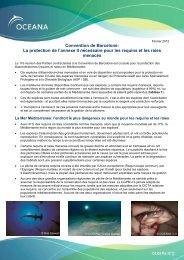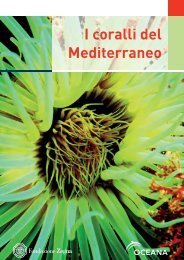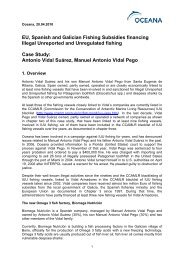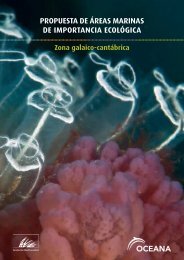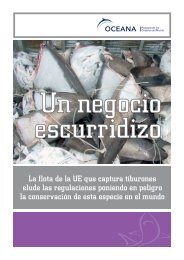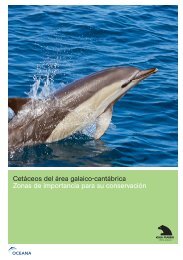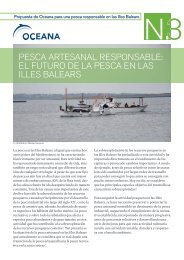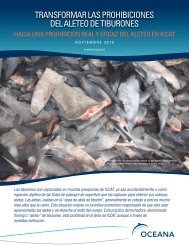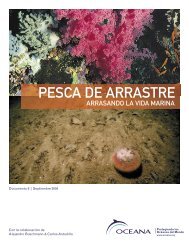Download - Oceana
Download - Oceana
Download - Oceana
Create successful ePaper yourself
Turn your PDF publications into a flip-book with our unique Google optimized e-Paper software.
2. Community dominated by the scleractinian Madrepora oculata on bathyal rocky bottom<br />
DESCRIPTION: Madrepora oculata, along with other scleractinians such as Lophelia pertusa or<br />
Solenosmilia variabilis, forms very deep-sea reefs. However, Madrepora oculata is not able to form reefs<br />
in some areas, but it does appear as the predominant species in some communities. In these cases,<br />
colonies of scleractinian appear more dispersed, mainly occupying vertical walls, canyon edges and rocky<br />
overhangs.<br />
Due to the fact that the density of Madrepora oculata in these cases is lower, it cannot be considered as a<br />
reef, but it can be included in the type of “coral garden” habitat.<br />
Also, when skeletons of colonies of dead Madrepora oculata cover the bottom area –which is known as<br />
rubbles, a habitat that is usually populated by many species of sponges and other cnidarians- it can be<br />
also considered as a “coral garden”.<br />
DEPTH: 205 - 245 m<br />
TYPE OF SUBSTRATE: Vertical walls or rocky overhangs, abrupt, with huge slope, sedimentary.<br />
TYPICAL FAUNA OF THE COMMUNITY<br />
PORIFERA<br />
Encrusted desmosponges cf. Suberites carnosus<br />
Geodia sp. Polymastia sp.<br />
CNIDARIA<br />
Acanthogorgia hirsuta Parazoanthus anguicomus<br />
Antipathes dichotoma Parazoanthus axinellae<br />
Dendrophyllia cornigera Polyplumaria flabellata<br />
Parantipathes hirondelle<br />
MOLLUSCA<br />
Eledone cirrhosa<br />
CRUSTACEA<br />
Homarus gammarus Munida sp.<br />
ECHINODERMATA<br />
Antedon sp. Marthasterias glacialis<br />
Echinus acutus Ophiothrix fragilis<br />
ANNELIDA<br />
Myxicola infundibulum Sabellidae<br />
ECHIURA<br />
Bonellia viridis<br />
BRACHIOPODA<br />
Cf. Megerlia truncata Cf. Novocrania anomala<br />
CHORDATA: PISCES<br />
Capros aper Gadiculus argenteus<br />
Lophius piscatorius Phycis blennoides<br />
AREAS WHERE THIS HABITAT IS PRESENT AND DOCUMENTED BY OCEANA<br />
LOCATION COUNTRY COORDINATES<br />
Aviles canyon Spain 43º 43,00235’N 06º 04,08362’W<br />
Aviles canyon Spain 43º 43,09842’N 06º 03,91510’W<br />
Aviles canyon Spain 43º 43,09717’N 06º 03,69090’W<br />
12



